We never thought we’d visit Chernobyl in winter – until we got the chance to join a Chernobyl tour, visiting the Chernobyl Exclusion Zone and the ghost town of Pripyat. Here’s all you need to know, including whether or not Chernobyl is safe, things to see in Chernobyl in winter and practical info!

One of my earliest memories dates back to April 1986. I was two and a half years old. I remember spending Easter in a house by the seaside, with a turtle roaming in the garden.
A little after Easter, I remember my mother stocking up canned fruit and vegetables, boxes and boxes of them – she had bought so many that some lay forgotten at the bottom of the cupboard, until we threw them out just a few years ago, twenty or more years after their expiration date.
I was so young, I can’t really remember how the Chernobyl disaster was perceived by my family. I only have vague recollections of how we didn’t eat fresh fruit and vegetables for six months, or more.
The radioactive cloud that lifted from the destroyed nuclear plant in the Soviet Union had drifted far and wide, reaching not only Western Europe, but also the United States and Canada.
Over the years, memories of Chernobyl became fewer and further between. Italy banned nuclear power in 1987, after a referendum with a record turnout. After the Fukushima disaster in 2011, the issue of nuclear power plants reached the news again – then, again, disappeared.
Chernobyl was all over the news again in 2019, thanks to the great HBO miniseries that retraced the history of the days before and after the fateful explosion – we really recommend watching the series before visiting Chernobyl, or if you prefer reading, there are many texts and books about the Chernobyl disaster.
This newfound fame brought a wave of self-styled influencers to the Exclusion Zone, and a spate of criticisms over their inappropriate behaviour in locations where this terrible tragedy unfolded.
For this reason, we’ve decided to put together this guide about our Chernobyl visit in winter – starting with a detailed account of what there is to see and do in Chernobyl, Prypiat and the Exclusion Zone, and ending with practical tips and important things to know before your Chernobyl visit.
Looking for a Chernobyl tour? Take a look below!
- From Kiev: Group Tour to Chernobyl and Prypiat with Lunch
- Chernobyl and Pripyat: Full-Day All inclusive Private Tour
- Helicopter Tour of Kiev and Chernobyl
- 1-Day Group Tour to the Chernobyl Exclusion Zone
- Day Trip to Chernobyl Exclusion Zone and Prypiat
- EXTREME 2-Day Chernobyl and Pripyat with Overnight Stay
Fears and Doubts about Visiting Chernobyl
Over the years, I had heard of people who had visited Chernobyl, and saw pictures from Pripyat, a ghost town in the Chernobyl Exclusion Zone – usually on clickbait websites, showing row upon row of deserted Soviet apartment buildings, a Ferris wheel with paint peeling in the wind, and bumper cars covered in snow, scattered around a rusted playground.
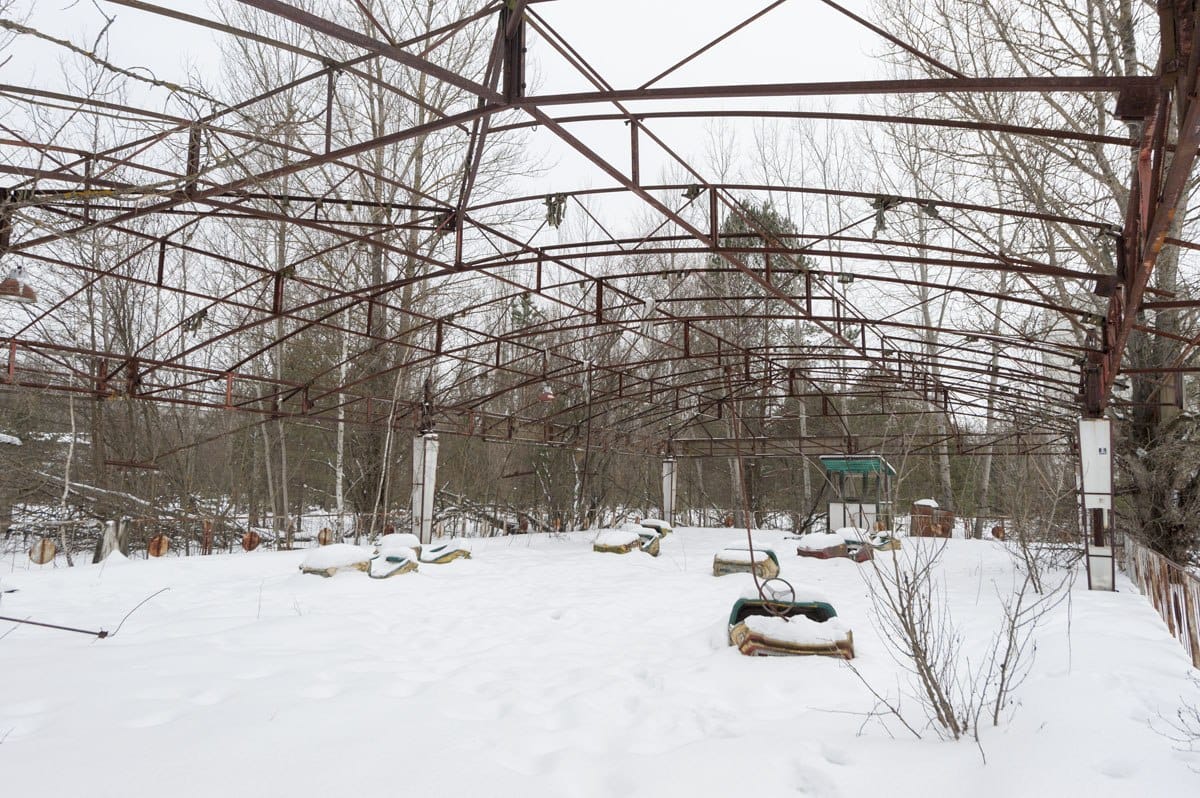
I read somewhere that Ukrainian companies were organising Chernobyl tours, including visits to Pripyat, but was it safe?
Levels of radiation would contaminate the Chernobyl Exclusion Zone for another 20,000 years – yes, you heard that right. 20,000 years. So, how is it even possible to visit Chernobyl, only 35 or so years after the disaster?
These questions were milling in my head as our plane touched down at Kiev-Boryspil airport. We had received a last minute invitation to join a Chernobyl tour and – once again – our curiosity was stronger than our fear.
We figured that if Chernobyl tours are allowed, then it must be safe to visit. Two days later, we were in Kiev – and the following day we were off to visit Chernobyl, Pripyat and other locations in the Chernobyl Exclusion Zone, in the middle of winter!

It was an early, freezing Saturday morning. Kiev looked as if it had fallen under a winter spell – the city was still and silent, and there were only a few people out and about, mostly locals ice fishing on the Dnieper river.
It would take us about two hours to travel to the Chernobyl Exclusion Zone, an area extending 30 km in all directions from the Chernobyl Power Plant, where the explosion occurred on April 26th, 1986.
We travelled across snowy fields and frozen lands, with fewer and fewer signs of human activity, until a sign saying Чорнобиль appeared before us, right next to a roadblock.
We were about to visit Chernobyl.
[Related: Cold War Berlin, A Divided City]
History of Chernobyl, Pripyat and the Exclusion Zone
Before we get into the details of our Chernobyl visit in winter, let me give you some background information.
The Chernobyl power station is located approximately 130 km from Kiev, close to the border with Belarus. The power station included four nuclear reactors – two more were under construction at the time of the accident, but were never completed.
The power station is located about 18 km north from the city of Chernobyl, after which it is named, an ancient town with a 1000 year history, famous for being one of the centers of Hasidic Judaism in the 19th century.
At the time of the catastrophe in April 1986, Chernobyl counted approximately 20,000 inhabitants.
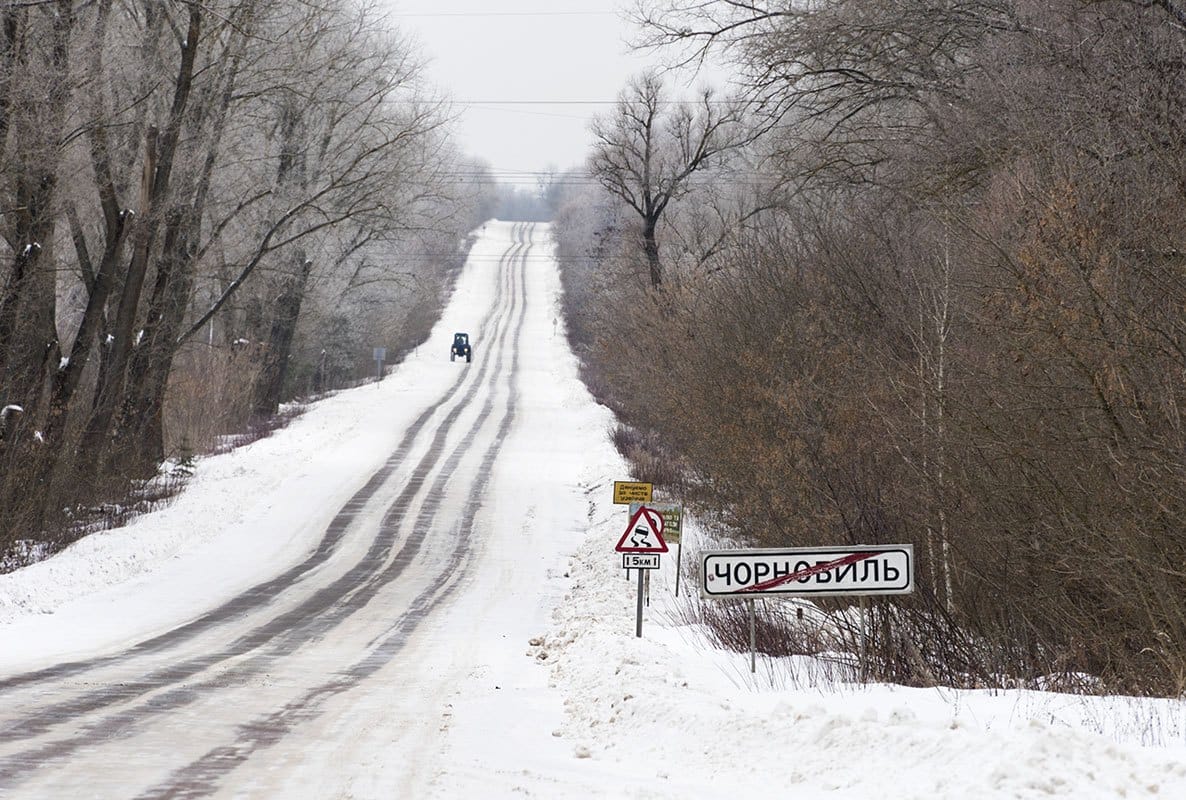
However, the closest town to the power station was not Chernobyl but Pripyat, about 5 km away. Pripyat was purposely built in the 1970s to provide accommodation for people working in the power station and their families.
It was a Communist model town with lots of green space, home to 50,000 people in 1986 – in two days, it was completely evacuated.
I won’t go into the technicalities of the Chernobyl explosion – first of all, because I can’t quite understand it myself.
Basically, following the explosion, a cloud of radioactive material rose from the destroyed reactor, and it was carried by the wind. The Soviet government didn’t immediately disclose the extent of the incident – and that is where watching the HBO series will really help you understand what went o
Pripyat wasn’t evacuated until 36 hours after the explosion, when several residents were already suffering from acute radiation sickness.
The Chernobyl Exclusion Zone was established after the tragedy – an area comprised within a 30 km radius from Reactor 4 of the Chernobyl Power Plant, where the catastrophe occurred.
The area was evacuated, and over 90,000 people were resettled elsewhere.

The Chernobyl Exclusion Zone is huge – at 2600 square kilometers, is larger than Luxembourg.
30 years after the Chernobyl disaster, the area remains uninhabited, save for a small number of samosely, or self-settlers – usually elderly people that have returned to their homes within the Exclusion Zone, and workers at the Chernobyl Power Plant.
The plant is currently under decommissioning, which is scheduled to end in 2065. In order to avoid the dangers of radiation, workers work in shifts, and rest for two weeks after a month of work.
Only tour groups are allowed to visit Chernobyl, and it’s necessary to follow some rules – eating, drinking or touching anything is not allowed, it’s necessary to stay in a group at all times, and buildings are off limits.
Within the 30 km Exclusion Zone there’s a smaller area, covering a radius of 10 km around the power station, where visitors undergo further checks. When leaving both exclusion zones, everyone needs to be checked for radiation – if clothes or shoes present high levels of radiation, they need to be left behind.
Things to see in Chernobyl, Pripyat and the Exclusion Zone
Chernobyl Town and Memorial
Our tour began in Chernobyl town – unlike Pripyat, Chernobyl is not a ghost town, as that’s where plant workers stay during their shifts.
However, a town that was once home to 20,000 people now houses about 100. Windows are shuttered. Shops stand empty, their lettering fading in the wind. In the height of winter, the town looks under a deep, dreamless slumber.
Our bus stopped at various points of interest within Chernobyl – a yard where decontaminating vehicles are abandoned, a memorial dedicated to the heroic firefighters who braved radiation to put out the fire in the power plant, only to die of acute radiation sickness a few days later.
Right in the middle of Chernobyl Town there’s a monument of a winged angel, a reference to the Book of Revelations:
And the third angel sounded, and there fell a great star from heaven, burning as it were a lamp, and it fell upon the third part of the rivers, and upon the fountains of waters; And the name of the star is called Wormwood: and the third part of the waters became wormwood; and many men died of the waters, because they were made bitter. (Revelation 8:10-11)
The word ‘Chernobyl’ means wormwood in Ukrainian – which led some people to believe that the Chernobyl disaster was, in fact, predicting the end of days.
The DUGA
Soon afterwards, we approached the most chilling, daunting and – in some way – breathtaking sight of our Chernobyl in winter tour.
I had seen the ferris wheel, I had seen the empty buildings of Pripyat. But I had no idea about the DUGA, a super-secret Soviet radar, powerful enough to detect potential missiles coming from US airspace.
During the Cold War, it was known that there was something there, but nobody actually knew what it was. The DUGA was nicknamed ‘the Russian Woodpecker’ because of the maddening tapping noise it made, disrupting radio communication halfway across the world.

From afar, the DUGA looks like a wall separating two separate parallel dimensions. Up close, you’ll see it’s in fact a mesh, a 500 meter long, 90-meter high juggernaut of twisted steel tubes, raising up from the frozen ground, mighty and impassable, like a post-modern version of The Wall from Game of Thrones.
No one knew what the DUGA actually was, or even that it existed, until it was opened to the public in 2013.
On the maps, the area was marked as a children’s summer camp. Those into conspiracy theories believed the DUGA was a machine to control people’s minds, or the weather, or the route of submarines.
Its existence may even be the reason why the Chernobyl power plant was built in that specific location – such a massive structure needed an enormous amount of power to operate.
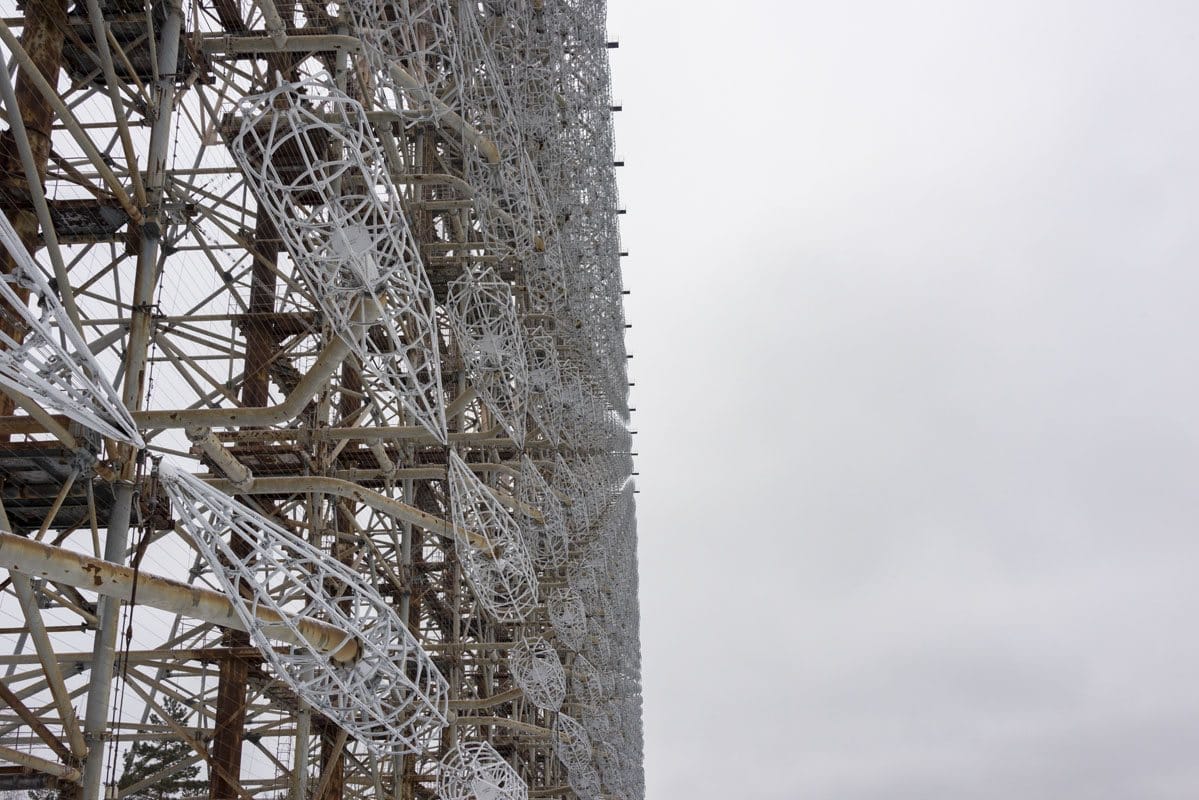
The DUGA is stunning. It’s scary. It’s a parody of the 20th century – the technological advancement, the paranoia and mind control, dictatorship, power struggles and nothingness.
Standing there, in the middle of frozen Ukraine, the DUGA looked like a cruel joke. Pointless. Useless. So much death, so much destruction – a whole region condemned to be a wasteland for the foreseeable future, and all for what?
[Related: Bratislava Communist Architecture]
The Kopachi Kindergarten
Afterwards, we headed to the Kopachi kindergarten, one of the few buildings that can be visited from the inside.
The village of Kopachi, just 7 km from Reactor 4, was so badly contaminated that it had to be buried – the kindergarten is one of the few buildings left standing.
Inside, it looked – and felt – like a nightmare. Disheveled dolls with missing eyes were scattered around the place. The roof was caved in. In the former dormitory, bed frames rusted away, exposed to the elements.
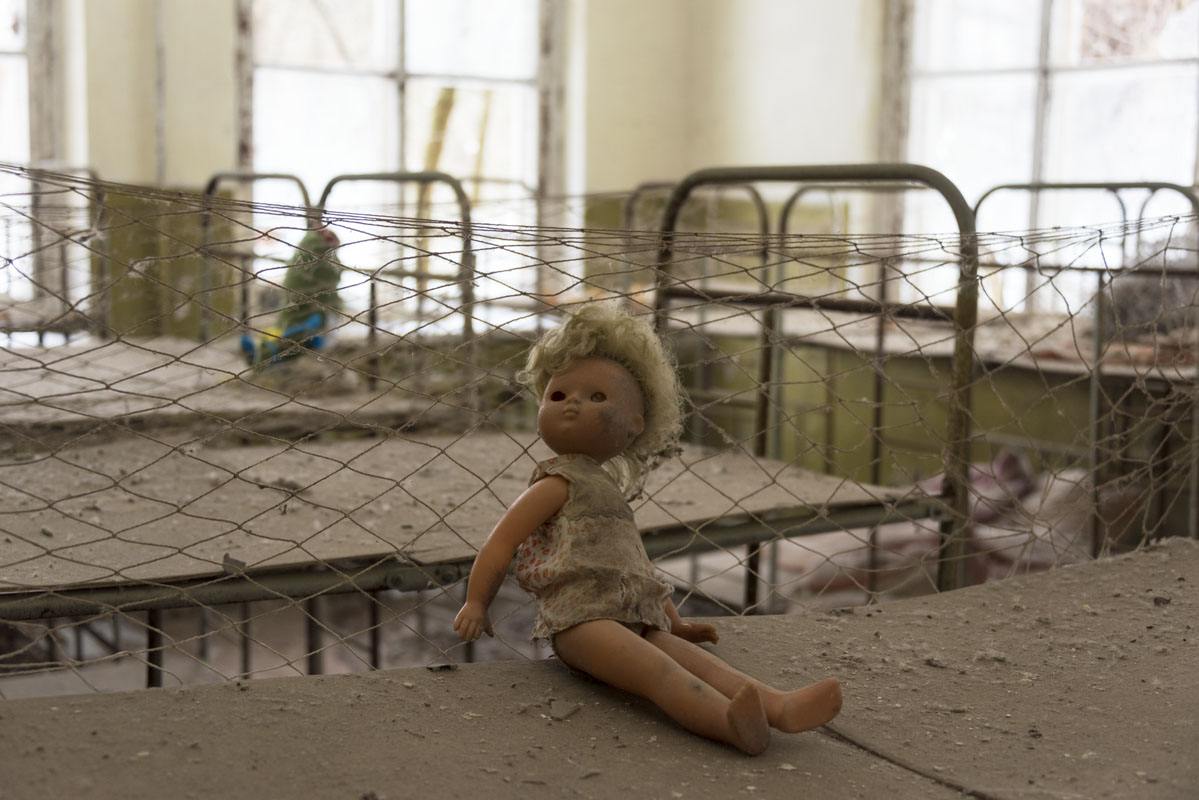
I don’t know what was real and what was not – had the dolls actually been left by the children as they were hastily evacuated? Or had they been added later, to emphasise the nightmarish feel of the place?
No one seemed to be sure. What I can say, though, was that it was a terrifying place. Inside the building it was even colder than outside – there was no sign of life, just neglect and dereliction.
Outside the building, we switched on our dosimeters. The safe level is below 0.3 rem – and throughout the Chernobyl Exclusion Zone, levels were usually within that range.
The Chernobyl Red Forest
However, our guide showed us that ‘radiation hotspots’ still exist – for instance, he placed the Geiger counter next to a tree, and the level quickly rocketed up to 25 rem.
Radiation are carried by particles, like dust and soil. For this reason, visiting Chernobyl in winter is actually a wise choice – the snow acts as a blanket, making sure radioactive particles stay in place.
A dry, windy day can see radiation levels triple. Trees are often radiation hotspots, as they absorb radioactive elements from the soil. The Red Forest, a woodland around the Chernobyl Power Station, is one of the most heavily contaminated places in the world, with levels reaching up to 10,000 rem.
The name ‘Red Forest’ was given because of the ginger-brown colour of the trees, dead after having absorbed record amounts of radiation.
[Related: Things to do in Moscow]

Chernobyl Reactor 4
From the Kopachi kindergarten we could see the profile of the ‘sarcophagus’, a huge concrete arch-like structure built around the ruined Reactor 4, to prevent radiation from escaping.
The area around Reactor 4 is currently under decommissioning, there are people at work and it’s forbidden to photograph anything besides the sarcophagus – for this reason, we could only stop very briefly before making for the last stop of the tour, Pripyat.

The sarcophagus looked unassuming from the outside – but inside, it hides a dark and terrible secret. The Elephant’s Foot, a mass of highly radioactive material looking like molten lava, that is so toxic it can kill a person within a matter of minutes.
The Elephant’s foot is made of a substance called corium, an amalgam of melted nuclear fuel and melted control rods, the most toxic substance on earth. That’s why the sarcophagus needed to be built – this substance is so toxic it cannot just be removed.
Visiting Pripyat
After a short drive from the sarcophagus, we were in Pripyat. Our bus dropped us off, and we all headed towards the Ferris wheel. The wheel was meant to be the centrepiece of the Pripyat amusement park, meant to open on May Day, 1986 – four days after the catastrophe.
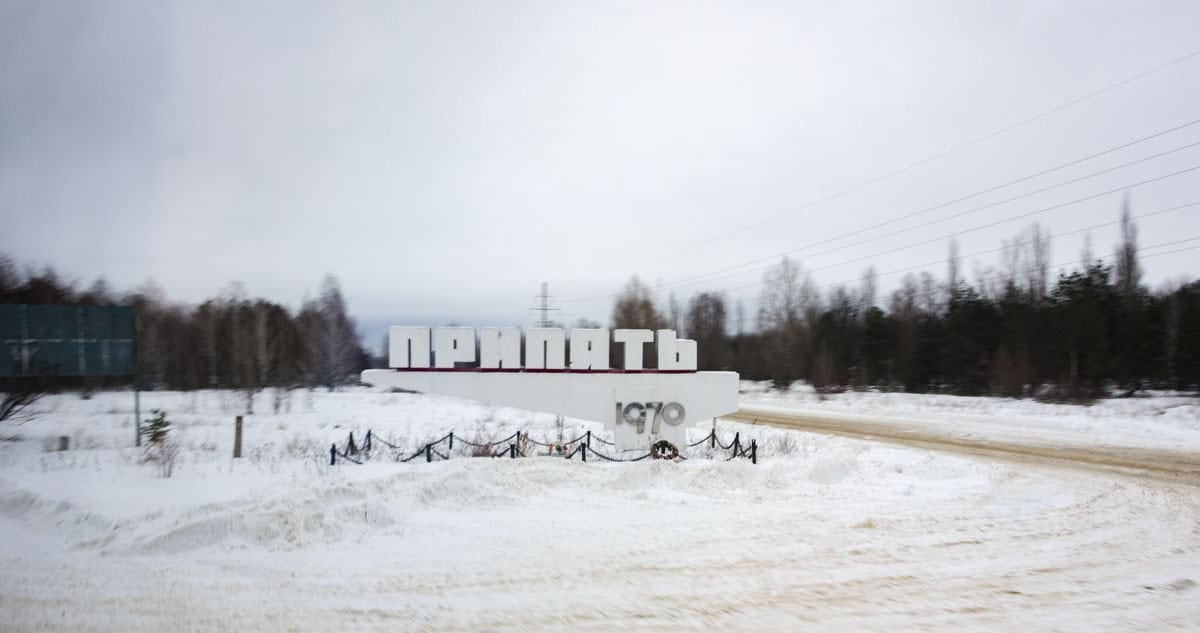
‘Pripyat était une ville heureuse’, our French guide told us. A happy city. The average age of the 50,000 inhabitants was only 26. There were lots of children, schools, beautiful homes like nowhere else in the country.
In Pripyat, there were also 3 swimming pools, 2 stadiums, one park, 35 playgrounds – and the children of Pripyat were about to receive a gift, their very own amusement park with a ferris wheel, swing boats, bumper cars and a carnival shooting range.
Only, it was never meant to happen. The catastrophe happened instead, and 50,000 people had to leave their homes and their things behind.
‘It will only be for a few days‘, they were told – and so most of their belongings were left behind. No one was ever to return, and slowly slowly, nature started creeping back on Pripyat, reclaiming what man once took.

It was hard to see, in the height of winter, when the snow covered everything. That day, Pripyat looked dead. There was not a single sign of life, and there will never be again.
The main square was derelict – on one side there was the stocky frame of the hotel Polyssia, once upon a time the best hotel in Pripyat. On the other side, the Palace of Culture Energetik, the former palace of culture including a boxing ring, gymnasium, a cinema, swimming pool and more.
Pripyat residents were never allowed back to claim their belongings, and so over the years the town was looted and vandalised.
Once a happy city, that now looks like the image of misery.
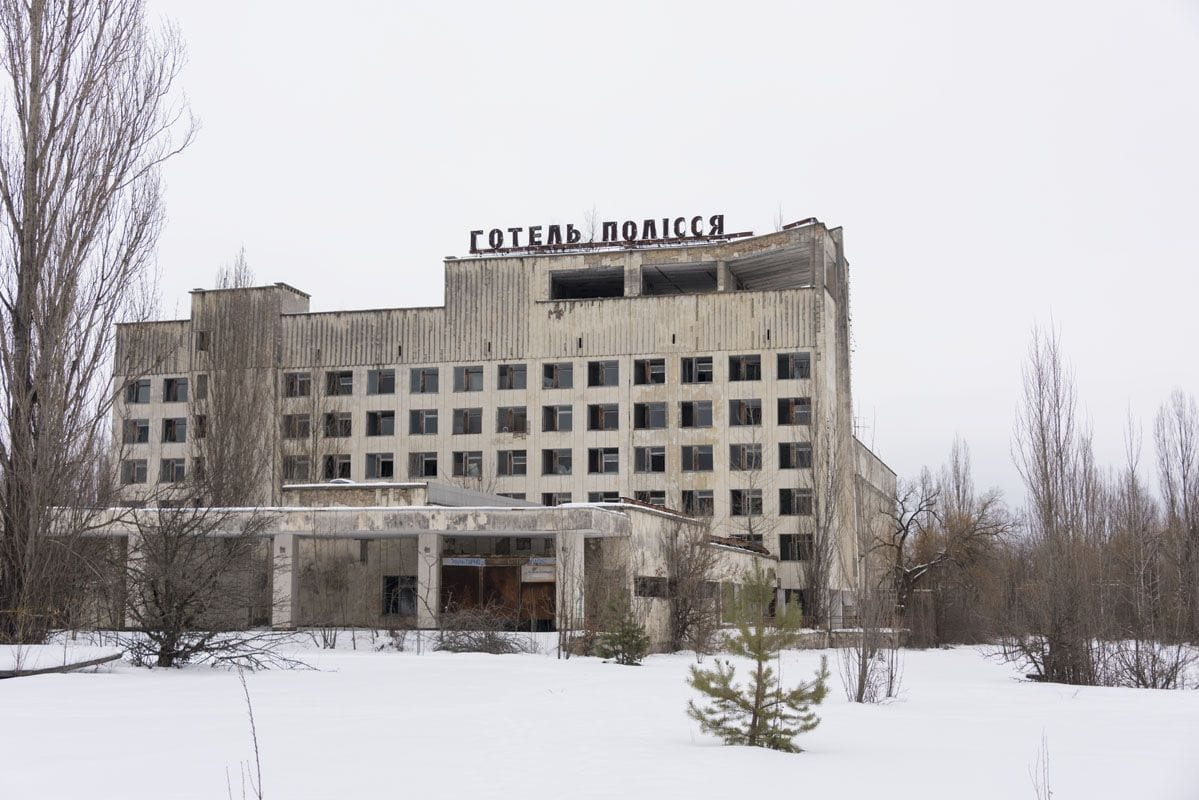
Nature in Chernobyl and Pripyat
But maybe, not all is lost. Nature is coming back in full force. Wildlife is thriving in the Chernobyl Exclusion Zone, with record number of bears, wolves, lynx and foxes. Our guide said that in summer the trees grow tall and green, blocking the empty buildings from view.
Bushes sprout from the cracks in the pavement, weeds fill the gaps between one broken step and another.
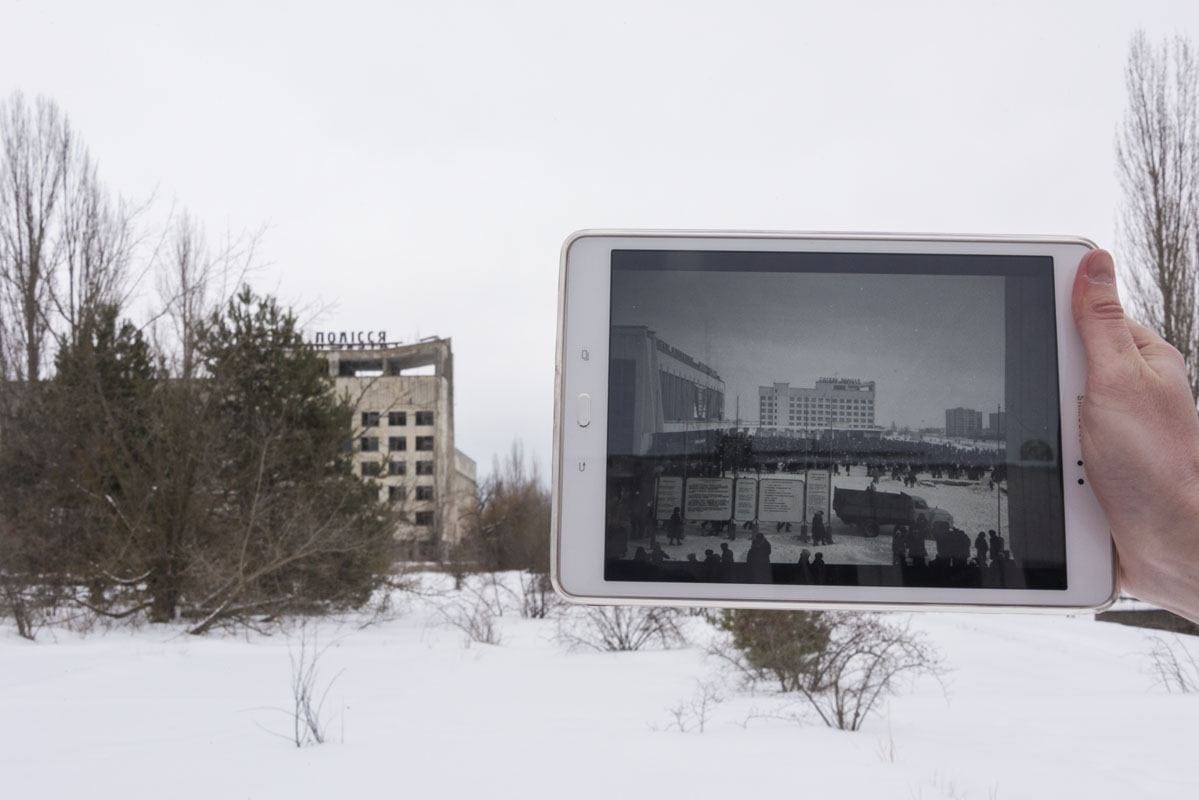
When it was time to go, a member of our group stayed back. We all left, and everything was still and silent, muted in the blue hour of the evening.
A fox came out from the shells of buildings, and crossed the empty square – a flash of auburn in a grey-white scene. A flash of colour, of life, in a place that the world had given up for dead.
Things to Know about Chernobyl
Is it safe to visit Chernobyl?
I’m sure some of you may be wondering if it is actually safe to visit Chernobyl. Our guides ensured that spending a day in the Chernobyl Exclusion Zone we would be exposed to the same level of radiation as during a medium haul flight.
On top of that, there are about 130 people living inside the Exclusion Zone, plus many more people travelling to the Chernobyl Exclusion Zone daily to work, taking part in the long process of decommissioning the reactor.
Every person going in and out of the Chernobyl Exclusion Zone needs to go through a radiation control checkpoint, and anyone found exceeding the minimum amount undergoes contamination.
I cannot stress the importance of following guidelines, sticking to the group and not doing anything stupid – please remember these words when you visit Chernobyl!
Is visiting Chernobyl worth it?
I can’t recommend visiting Chernobyl highly enough. It’s hard to give shape to my feelings, when visiting such a poignant place – but I would say that overall, prevailing feelings weren’t sadness or desperation. Chernobyl is not Auschwitz. It’s not the Killing Fields of Cambodia – at least, I didn’t experience the same.
In a way, Chernobyl is a place that like no other on earth symbolizes the 20th century, and the endless struggle between technological advancement, supremacy and destruction that dominated the ‘Age of Extremes’.
Visiting Chernobyl is a journey through recent history – recent because many of us still remember it, recent because really, who’s to say it won’t happen again?
But what have we learned from Chernobyl? If you’re like me, you’ll end your Chernobyl tour with more questions than answers.
Can you visit Chernobyl without a guide?
The short answer is no. Chernobyl visits are only allowed in the company of an official tour guide, and it’s necessary to go through checkpoints on the way in and out, especially for YOUR safety.
There are indeed unofficial reports of people ‘breaking in’ and spending a week or more roaming the Exclusion Zone, but it’s very, very dangerous – some areas are still heavily contaminated.
How long are Chernobyl tours?
Most Chernobyl tours are day trips from Kiev – half-day tours are not available, as it takes two hours each way to reach Chernobyl from Kiev.
It’s also possible to visit Chernobyl for two or three days, or arrange a private tour.
How much does it cost to visit Chernobyl?
Chernobyl day trips start from about €90 per person, including lunch in a Soviet-style restaurant. 2-day trips are around €250 per person, and private tours start at €200 for one day, and up to €1200 for three.
Take a look at some great Chernobyl tours below!
- From Kiev: Group Tour to Chernobyl and Prypiat with Lunch
- Chernobyl and Pripyat: Full-Day All inclusive Private Tour
- Helicopter Tour of Kiev and Chernobyl
- 1-Day Group Tour to the Chernobyl Exclusion Zone
- Day Trip to Chernobyl Exclusion Zone and Prypiat
- EXTREME 2-Day Chernobyl and Pripyat with Overnight Stay
Is it possible to stay in the Chernobyl Exclusion Zone?
Yes, you can! Chernobyl tours lasting two days or longer include overnight accommodation in villages inside the Exclusion Zone. We didn’t have the chance to experience this, but it sounds like a great way to get first-hand accounts from locals.
What is the best time to visit Chernobyl?
It’s possible to visit Chernobyl year round, but the best and safest time to visit is winter.
First of all, visiting Chernobyl in the snow adds to the strange, eerie atmosphere of the place – but also, don’t forget that radioactive particles are solid, so the snow actually covers them and prevents them from blowing around.
In any case, remember that Chernobyl tours only visit ‘safe’ spots, and you go through a checkpoint on the way out. So, it’s always safe to visit – but winter is extra safe!
Can you eat food and drink water from Chernobyl?
Absolutely not. The radioactive particles from the 1986 explosion are in the soil now – for this reason, water, fruit and vegetables from the Chernobyl Exclusion Zone should never be consumed.
Visitors should minimise their contact with the soil – we were told no sitting, no lying on the floor or even throwing snow balls. Also, it’s recommended to wear closed shoes, long sleeves and pants, in order to avoid naked skin coming into contact with radioactive particles.
Visit Chernobyl – Practical Tips
How to Get to Chernobyl
Our Chernobyl visit was organised through Planet Chernobyl, a French tour operator planning weekend packages from Paris, Brussels, Frankfurt, London and Geneva.
The price of the weekends is 690 € per person, and includes visits of Chernobyl and Kiev, direct flight with Ukraine International Airlines, transfers to and from the airport and 2 nights accommodation in a four-star hotel.
Where to Stay in Kiev
Kiev was a really lovely city, for what little we could see. Our accommodation in Kiev was at the Radisson Blu Hotel, a lovely four star property right into the centre of town, offering comfortable accommodation and some truly amazing breakfasts!
Here are other Kiev hotels worth checking out if the Radisson is full!
- Hyatt Regency – modern look and great location!
- Fairmont Grand – with a great spa and swimming pool
- Vozdvyzhensky Hotel – boutique hotel in the historic centre!
- Premier Palace – probably the most luxurious hotel in Kiev!
Where to Eat in Kiev
Kiev is also home to some really great restaurants. During out two nights in Kiev we had dinner in two restaurants, both offering amazing dinners, very different from one another but both really delicious.
The first night we visited Kanapa, a restaurant serving traditional Ukrainian cuisine with a creative twist – our amuse bouche was a canape of salmon skin with caviar and oyster jelly (I think!), followed by a delicious borscht served inside a hollowed-out cabbage and a salad that contained duck tongues – a lot better than it sounds!
The following night we headed to one of the coolest reastaurants I’ve visited in quite some time – Ostanya Barykada, a ‘secret’ restaurants located in the back of a gift shop inside an underground shopping centre (yes, really!)
Ostanya Barykada means ‘the last barricade’, and the restaurant is full of symbolism related to Ukraine’s struggle for independence during the Soviet domination.
The restaurant is 100% dedicated to Ukrainian cuisine – even the bar only sells Ukrainian products! Nick’s wish of having chicken Kiev in Kiev came true, and the rest of the menu was really good.
We would like to thank Planet Chernobyl for having invited us to join their inaugural tour.
Pin it for later?
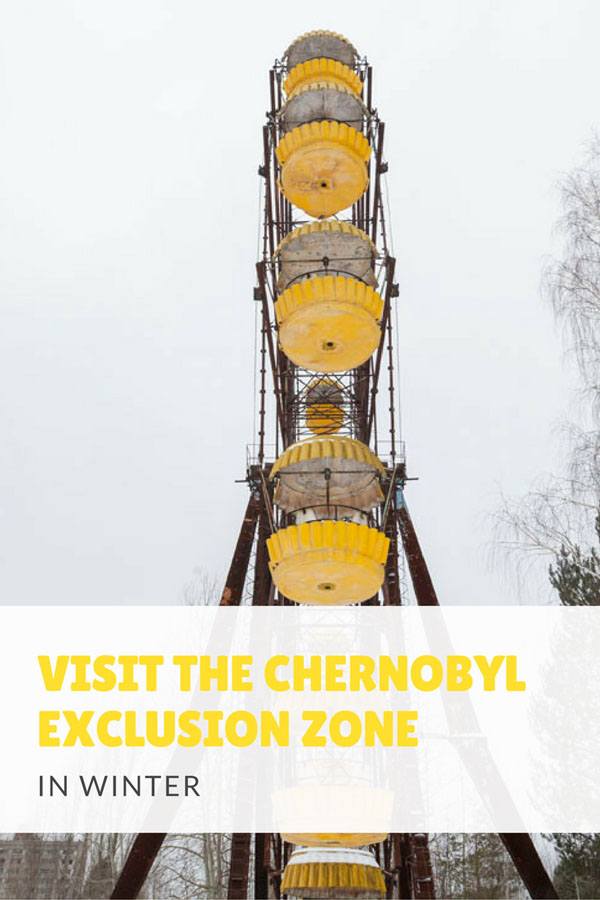
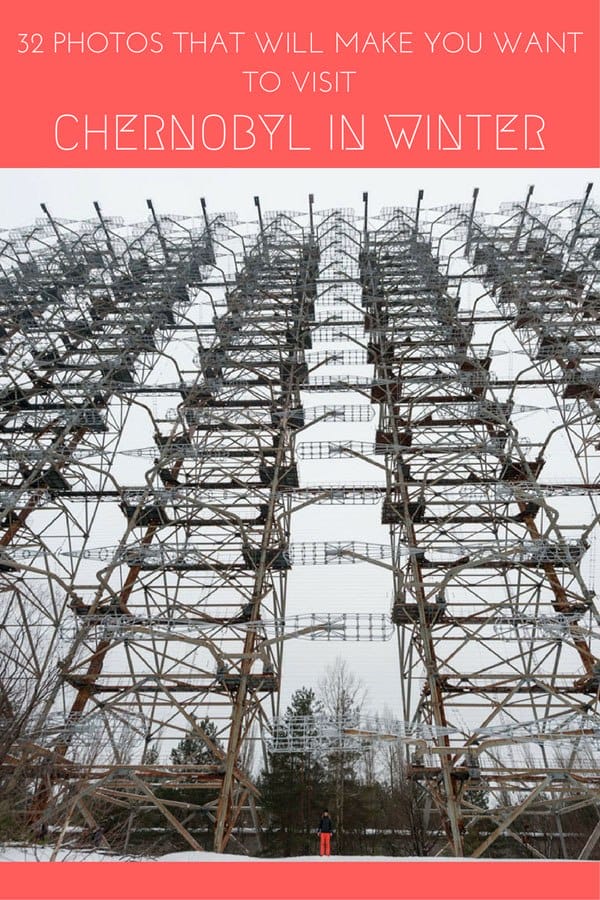
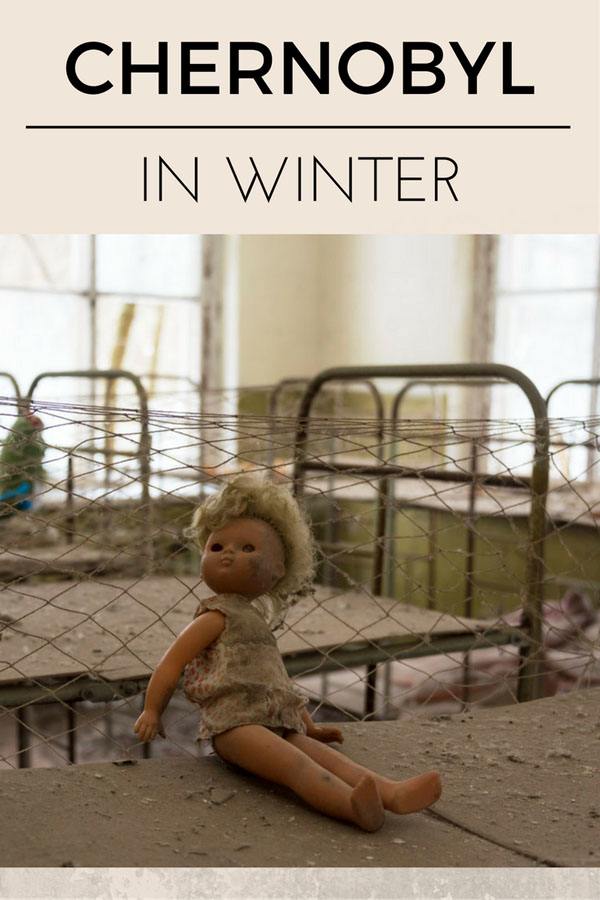

Thank you for coming and for this long but interesting and explanatory post.
We also loved the pics !
Thank you for having us!
Hey Margherita,
Thanks for this informative post. It’s quite interesting to know that people can tour the area. More interesting is the logistics of going in and out. The thought of radiation checks post-tour is a bit offsetting. I’m not sure what length I’d go to to tour this place considering the high levels present. Perhaps if it was simply the same as an x-ray scan that might be convincing enough through your analogy of it as a medium haul flight does well enough.
Some day when I’m in Eastern Europe I’ll swing by Chernobyl. This seems like a good place to visit given the Cold War history. Thanks for this informative post.
Cheers,
Mark
Thank you for reading it!